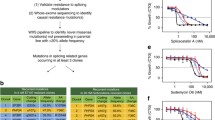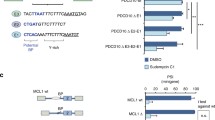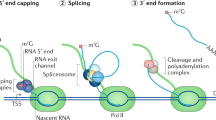Abstract
In this chapter, the essential role of the SF3b multi-protein complex will be discussed in the context of the overall spliceosome. SF3b is critical during spliceosome assembly for recognition of the branch point (BP) adenosine and, by de facto, selection of the 3′ splice site. This complex is highly dynamic, undergoing significant conformational changes upon loading of the branch duplex RNA and in its relative positioning during spliceosomal remodeling from the A, pre-B, B, Bact and B* complexes. Ultimately, during the spliceosome activation phase, SF3b must be displaced to unmask the branch point adenosine for the first splicing reaction to occur. In certain cancers, such as the hematological malignancies CML, CLL and MDS, the SF3b subunit SF3B1 is frequently mutated. Recent studies suggest these mutations lead to inappropriate branch point selection and mis-splicing events that appear to be drivers of disease. Finally, the SF3b complex is the target for at least three different classes of natural product-based inhibitors. These inhibitors bind in the BP adenosine-binding pocket and demonstrate a pre-mRNA competitive mechanism of action resulting in either intron retention or exon skipping. These compounds are extremely useful as chemical probes to isolate and characterize early stages of spliceosome assembly. They are also being explored preclinically and clinically as possible agents for hematological cancers.
Access this chapter
Tax calculation will be finalised at checkout
Purchases are for personal use only
Similar content being viewed by others
Abbreviations
- BP:
-
Branch point
- BPRS:
-
Branch point recognition sequence
- BS:
-
Branch sequence
- BSL:
-
Branch stem loop
- CMML:
-
Chronic myelomonocytic leukemia
- CLL:
-
Chronic lymphocytic leukemia
- EM:
-
Electron microscopy
- ILS:
-
Intron lariat spliceosome
- ISL:
-
Internal stem loop
- MDS:
-
Myelodysplastic syndromes
- mRNA:
-
Messenger RNA
- NMD:
-
Nonsense-mediated decay
- NMR:
-
Nuclear magnetic resonance
- NTC:
-
Nineteen complex
- NTR:
-
Nineteen related
- Plad:
-
Pladienolide
- PY:
-
Polypyrimidine
- RNA:
-
Ribonucleic acid
- RRM:
-
RNA recognition motif
- SF:
-
Splicing factor
- snRNP:
-
Small nuclear ribonucleoproteins
- snRNA:
-
Small nuclear RNAs
- SS:
-
Splice site
- ULM:
-
U2AF ligand motifs
- UHM:
-
U2AF homology motif
- U2AF:
-
U2 auxiliary factor
- WT:
-
Wild type
References
Agafonov DE, Deckert J et al (2011) Semiquantitative proteomic analysis of the human spliceosome via a novel two-dimensional gel electrophoresis method. Mol Cell Biol 31(13):2667–2682
Agrawal AA, Salsi E et al (2016) An extended U2AF(65)-RNA-binding domain recognizes the 3’ splice site signal. Nat Commun 7:10950
Agrawal AA, Yu L et al (2018) Targeting splicing abnormalities in cancer. Curr Opin Genet Dev 48:67–74
Allan RK, Ratajczak T (2011) Versatile TPR domains accommodate different modes of target protein recognition and function. Cell Stress Chaperones 16(4):353–367
Alsafadi S, Houy A et al (2016) Cancer-associated SF3B1 mutations affect alternative splicing by promoting alternative branchpoint usage. Nat Commun 7:10615
Bai R, Wan R et al (2018) Structures of the fully assembled Saccharomyces cerevisiae spliceosome before activation. Science 360(6396):1423–1429
Bai R, Yan C, et al (2017) Structure of the post-catalytic spliceosome from Saccharomyces cerevisiae. Cell 171(7):1589–1598 e1588
Bertram K, Agafonov DE, et al (2017a) Cryo-EM structure of a pre-catalytic human spliceosome primed for activation. Cell 170(4):701–713 e711
Bertram K, Agafonov DE, et al (2017) Cryo-EM structure of a human spliceosome activated for step 2 of splicing. Nature 542(7641):318–323
Brosi R, Hauri HP et al (1993) Separation of splicing factor SF3 into two components and purification of SF3a activity. J Biol Chem 268(23):17640–17646
Buonamici S, Yoshimi A et al (2016) H3B-8800, an orally bioavailable modulator of the SF3b complex, shows efficacy in spliceosome-mutant myeloid malignancies. Blood 128:966
Charenton C, Wilkinson ME et al (2019) Mechanism of 5’ splice site transfer for human spliceosome activation. Science 364(6438):362–367
Chen HC, Tseng CK et al (2013) Link of NTR-mediated spliceosome disassembly with DEAH-box ATPases Prp2, Prp16, and Prp22. Mol Cell Biol 33(3):514–525
Corrionero A, Minana B et al (2011) Reduced fidelity of branch point recognition and alternative splicing induced by the anti-tumor drug spliceostatin A. Genes Dev 25(5):445–459
Corsini L, Bonnal S et al (2007) U2AF-homology motif interactions are required for alternative splicing regulation by SPF45. Nat Struct Mol Biol 14(7):620–629
Cretu C, Agrawal AA, et al (2018) Structural basis of splicing modulation by antitumor macrolide compounds. Mol cell 70(2):265–273 e268
Cretu C, Schmitzova J et al (2016) Molecular architecture of SF3b and structural consequences of its cancer-related mutations. Mol Cell 64(2):307–319
Darman RB, Seiler M et al (2015) Cancer-associated SF3B1 hotspot mutations induce cryptic 3’ splice site selection through use of a different branch point. Cell Rep 13(5):1033–1045
Fica SM, Oubridge C et al (2017) Structure of a spliceosome remodelled for exon ligation. Nature 542(7641):377–380
Fica SM, Oubridge C et al (2019) A human postcatalytic spliceosome structure reveals essential roles of metazoan factors for exon ligation. Science 363(6428):710–714
Finci LI, Zhang X et al (2018) The cryo-EM structure of the SF3b spliceosome complex bound to a splicing modulator reveals a pre-mRNA substrate competitive mechanism of action. Genes Dev 32(3–4):309–320
Folco EG, Coil KE et al (2011) The anti-tumor drug E7107 reveals an essential role for SF3b in remodeling U2 snRNP to expose the branch point-binding region. Genes Dev 25(5):440–444
Galej WP, Wilkinson ME et al (2016) Cryo-EM structure of the spliceosome immediately after branching. Nature 537(7619):197–201
Garcia-Alonso S, Ocana A et al (2020) Trastuzumab emtansine: mechanisms of action and resistance, clinical progress, and beyond. Trend Cancer 6(2):130–146
Golas MM, Sander B et al (2003) Molecular architecture of the multiprotein splicing factor SF3b. Science 300(5621):980–984
Gozani O, Potashkin J et al (1998) A potential role for U2AF-SAP 155 interactions in recruiting U2 snRNP to the branch site. Mol Cell Biol 18(8):4752–4760
Hang J, Wan R et al (2015) Structural basis of pre-mRNA splicing. Science 349(6253):1191–1198
Hasegawa M, Miura T et al (2011) Identification of SAP155 as the target of GEX1A (Herboxidiene), an antitumor natural product. ACS Chem Biol 6(3):229–233
Haselbach D, Komarov I et al (2018) Structure and conformational dynamics of the human spliceosomal B(act) complex. Cell 172(3):454–464 e411
Hong DS, Kurzrock R et al (2014) A phase I, open-label, single-arm, dose-escalation study of E7107, a precursor messenger ribonucleic acid (pre-mRNA) splicesome inhibitor administered intravenously on days 1 and 8 every 21 days to patients with solid tumors. Invest New Drugs 32(3):436–444
Horowitz DS (2012) The mechanism of the second step of pre-mRNA splicing. Wiley Interdisc Rev RNA 3(3):331–350
Inoue D, Chew GL et al (2019) Spliceosomal disruption of the non-canonical BAF complex in cancer. Nature 574(7778):432–436
Kaida D, Motoyoshi H et al (2007) Spliceostatin A targets SF3b and inhibits both splicing and nuclear retention of pre-mRNA. Nat Chem Biol 3(9):576–583
Kastner B, Will CL et al (2019) Structural insights into nuclear pre-mRNA splicing in higher eukaryotes. Cold Spring Harbor Persp Biol 11(11)
Kondo Y, Oubridge C, et al (2015) Crystal structure of human U1 snRNP, a small nuclear ribonucleoprotein particle, reveals the mechanism of 5’ splice site recognition. eLife 4
Kotake Y, Sagane K et al (2007) Splicing factor SF3b as a target of the antitumor natural product pladienolide. Nat Chem Biol 3(9):570–575
Kramer A, Gruter P et al (1999) Combined biochemical and electron microscopic analyses reveal the architecture of the mammalian U2 snRNP. J Cell Biol 145(7):1355–1368
Landau DA, Carter SL et al (2013) Evolution and impact of subclonal mutations in chronic lymphocytic leukemia. Cell 152(4):714–726
Lardelli RM, Thompson JX et al (2010) Release of SF3 from the intron branchpoint activates the first step of pre-mRNA splicing. RNA 16(3):516–528
Li X, Liu S et al (2019) A unified mechanism for intron and exon definition and back-splicing. Nature 573(7774):375–380
Lin PC, Xu RM (2012) Structure and assembly of the SF3a splicing factor complex of U2 snRNP. EMBO J 31(6):1579–1590
Liu S, Li X et al (2017) Structure of the yeast spliceosomal postcatalytic P complex. Science 358(6368):1278–1283
Liu Z, Luyten I et al (2001) Structural basis for recognition of the intron branch site RNA by splicing factor 1. Science 294(5544):1098–1102
Loerch S, Leach JR et al (2019) The pre-mRNA splicing and transcription factor Tat-SF1 is a functional partner of the spliceosome SF3b1 subunit via a U2AF homology motif interface. J Biol Chem 294(8):2892–2902
Loerch S, Maucuer A et al (2014) Cancer-relevant splicing factor CAPERalpha engages the essential splicing factor SF3b155 in a specific ternary complex. J Biol Chem 289(25):17325–17337
Miller-Wideman M, Makkar N et al (1992) Herboxidiene, a new herbicidal substance from Streptomyces chromofuscus A7847. Taxonomy, fermentation, isolation, physico-chemical and biological properties. J Antibio 45(6):914–921
Mizui Y, Sakai T et al (2004) Pladienolides, new substances from culture of Streptomyces platensis Mer-11107. III. In vitro and in vivo antitumor activities. J Antibio 57(3):188–196
Nakajima H, Sato B et al (1996) New antitumor substances, FR901463, FR901464 and FR901465. I. Taxonomy, fermentation, isolation, physico-chemical properties and biological activities. J Antibio 49(12):1196–1203
Newman AJ, Norman C (1992) U5 snRNA interacts with exon sequences at 5’ and 3’ splice sites. Cell 68(4):743–754
Obeng EA, Chappell RJ et al (2016) Physiologic expression of Sf3b1(K700E) causes impaired erythropoiesis, aberrant splicing, and sensitivity to therapeutic spliceosome modulation. Cancer Cell 30(3):404–417
Ohrt T, Odenwalder P et al (2013) Molecular dissection of step 2 catalysis of yeast pre-mRNA splicing investigated in a purified system. RNA 19(7):902–915
Paolella BR, Gibson WJ, et al (2017) Copy-number and gene dependency analysis reveals partial copy loss of wild-type SF3B1 as a novel cancer vulnerability. eLife 6
Patnaik MM, Lasho TL et al (2013) Spliceosome mutations involving SRSF2, SF3B1, and U2AF35 in chronic myelomonocytic leukemia: prevalence, clinical correlates, and prognostic relevance. Am J Hematol 88(3):201–206
Pauling MH, McPheeters DS et al (2000) Functional Cus1p is found with Hsh155p in a multiprotein splicing factor associated with U2 snRNA. Mol Cell Biol 20(6):2176–2185
Perriman R, Ares M Jr (2010) Invariant U2 snRNA nucleotides form a stem loop to recognize the intron early in splicing. Mol Cell 38(3):416–427
Plaschka C, Lin PC et al (2017) Structure of a pre-catalytic spliceosome. Nature 546(7660):617–621
Plaschka C, Lin PC et al (2018) Prespliceosome structure provides insights into spliceosome assembly and regulation. Nature 559(7714):419–422
Pomeranz Krummel DA, Oubridge C et al (2009) Crystal structure of human spliceosomal U1 snRNP at 5.5 A resolution. Nature 458(7237):475–480
Puthenveetil S, Loganzo F et al (2016) Natural product splicing inhibitors: a new class of antibody-drug conjugate (ADC) payloads. Bioconjug Chem 27(8):1880–1888
Query CC, Strobel SA et al (1996) Three recognition events at the branch-site adenine. EMBO J 15(6):1392–1402
Rauhut R, Fabrizio P et al (2016) Molecular architecture of the Saccharomyces cerevisiae activated spliceosome. Science 353(6306):1399–1405
Roybal GA, Jurica MS (2010) Spliceostatin A inhibits spliceosome assembly subsequent to prespliceosome formation. Nucleic Acids Res 38(19):6664–6672
Seiler M, Yoshimi A et al (2018) H3B-8800, an orally available small-molecule splicing modulator, induces lethality in spliceosome-mutant cancers. Nat Med 24(4):497–504
Shi Y (2017) The spliceosome: a protein-directed metalloribozyme. J Mol Biol 429:2640–2653
Sontheimer EJ, Steitz JA (1993) The U5 and U6 small nuclear RNAs as active site components of the spliceosome. Science 262(5142):1989–1996
Stepanyuk GA, Serrano P, et al (2016) UHM-ULM interactions in the RBM39-U2AF65 splicing-factor complex. Acta Crystallograph Sect D Struct Biol 72(Pt 4):497–511
Tang Q, Rodriguez-Santiago S et al (2016) SF3B1/Hsh155 HEAT motif mutations affect interaction with the spliceosomal ATPase Prp5, resulting in altered branch site selectivity in pre-mRNA splicing. Genes Dev 30(24):2710–2723
Teng T, Tsai JH et al (2017) Splicing modulators act at the branch point adenosine binding pocket defined by the PHF5A-SF3b complex. Nat Commun 8:15522
Thickman KR, Swenson MC et al (2006) Multiple U2AF65 binding sites within SF3b155: thermodynamic and spectroscopic characterization of protein-protein interactions among pre-mRNA splicing factors. J Mol Biol 356(3):664–683
Toroney R, Nielsen KH et al (2019) Termination of pre-mRNA splicing requires that the ATPase and RNA unwindase Prp43p acts on the catalytic snRNA U6. Genes Dev 33(21–22):1555–1574
Tseng CK, Liu HL et al (2011) DEAH-box ATPase Prp16 has dual roles in remodeling of the spliceosome in catalytic steps. RNA 17(1):145–154
van der Feltz C, Hoskins AA (2019) Structural and functional modularity of the U2 snRNP in pre-mRNA splicing. Crit Rev Biochem Mol Biol 54(5):443–465
van Roon AM, Oubridge C et al (2017) Crystal structure of U2 snRNP SF3b components: Hsh49p in complex with Cus1p-binding domain. RNA 23(6):968–981
Vigevani L, Gohr A et al (2017) Molecular basis of differential 3’ splice site sensitivity to anti-tumor drugs targeting U2 snRNP. Nat Commun 8(1):2100
Wan R, Bai R, et al (2019a) Structures of the catalytically activated yeast spliceosome reveal the mechanism of branching. Cell 177(2):339–351 e313
Wan R, Bai R, et al (2019b) How is precursor messenger RNA spliced by the spliceosome? Ann Rev Biochem
Wang W, Maucuer A et al (2013) Structure of phosphorylated SF1 bound to U2AF(6)(5) in an essential splicing factor complex. Structure 21(2):197–208
Wan R, Yan C et al (2016) Structure of a yeast catalytic step I spliceosome at 3.4 A resolution. Science 353(6302):895–904
Wan R, Yan C, et al (2017) Structure of an intron lariat spliceosome from Saccharomyces cerevisiae. Cell 171(1):120–132 e112
Wells SE, Neville M et al (1996) CUS1, a suppressor of cold-sensitive U2 snRNA mutations, is a novel yeast splicing factor homologous to human SAP 145. Genes Dev 10(2):220–232
Wilkinson ME, Charenton C, et al (2019) RNA splicing by the spliceosome. Ann Rev Biochem
Wilkinson ME, Fica SM et al (2017) Postcatalytic spliceosome structure reveals mechanism of 3’-splice site selection. Science 358(6368):1283–1288
Will CL, Schneider C et al (2001) A novel U2 and U11/U12 snRNP protein that associates with the pre-mRNA branch site. EMBO J 20(16):4536–4546
Xu YZ, Newnham CM et al (2004) Prp5 bridges U1 and U2 snRNPs and enables stable U2 snRNP association with intron RNA. EMBO J 23(2):376–385
Yan C, Hang J et al (2015) Structure of a yeast spliceosome at 3.6-angstrom resolution. Science 349(6253):1182–1191
Yan D, Perriman R et al (1998) CUS2, a yeast homolog of human Tat-SF1, rescues function of misfolded U2 through an unusual RNA recognition motif. Mol Cell Biol 18(9):5000–5009
Yan C, Wan R et al (2016) Structure of a yeast activated spliceosome at 3.5 A resolution. Science 353(6302):904–911
Yan C, Wan R et al (2017) Structure of a yeast step II catalytically activated spliceosome. Science 355(6321):149–155
Yokoi A, Kotake Y et al (2011) Biological validation that SF3b is a target of the antitumor macrolide pladienolide. FEBS J 278(24):4870–4880
Yoshida K, Ogawa S (2014) Splicing factor mutations and cancer. Wiley Interdisc Rev RNA 5(4):445–459
Yoshida K, Sanada M et al (2011) Frequent pathway mutations of splicing machinery in myelodysplasia. Nature 478(7367):64–69
Yoshimura SH, Hirano T (2016) HEAT repeats—versatile arrays of amphiphilic helices working in crowded environments? J Cell Sci 129(21):3963–3970
Zhang X, Yan C, et al (2017) An atomic structure of the human spliceosome. Cell 169(5):918–929 e914
Zhang X, Yan C et al (2018) Structure of the human activated spliceosome in three conformational states. Cell Res 28(3):307–322
Zhan X, Yan C et al (2018) Structure of a human catalytic step I spliceosome. Science 359(6375):537–545
Zhou Q, Derti A et al (2015) A chemical genetics approach for the functional assessment of novel cancer genes. Can Res 75(10):1949–1958
Author information
Authors and Affiliations
Corresponding author
Editor information
Editors and Affiliations
Rights and permissions
Copyright information
© 2021 Springer Nature Switzerland AG
About this chapter
Cite this chapter
Larsen, N.A. (2021). The SF3b Complex is an Integral Component of the Spliceosome and Targeted by Natural Product-Based Inhibitors. In: Harris, J.R., Marles-Wright, J. (eds) Macromolecular Protein Complexes III: Structure and Function. Subcellular Biochemistry, vol 96. Springer, Cham. https://doi.org/10.1007/978-3-030-58971-4_12
Download citation
DOI: https://doi.org/10.1007/978-3-030-58971-4_12
Published:
Publisher Name: Springer, Cham
Print ISBN: 978-3-030-58970-7
Online ISBN: 978-3-030-58971-4
eBook Packages: Biomedical and Life SciencesBiomedical and Life Sciences (R0)




